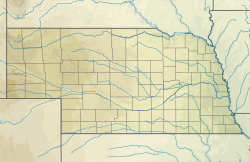| Red Willow Dam | |
|---|---|
| Country | United States |
| Location | Frontier County, Nebraska |
| Coordinates | 40°21′31″N100°40′02″W / 40.35863°N 100.66725°W |
| Status | Operationa |
| Construction began | 1960 |
| Opening date | 1962 |
| Designed by | United States Bureau of Reclamation |
| Dam and spillways | |
| Height | 126 ft (38 m) |
| Reservoir | |
| Creates | Hugh Butler Lake |
| Total capacity | 86,630 acre⋅ft (106,860,000 m3) |
| Surface area | 1,629 acres (659 ha) |
| Normal elevation | 2,510 ft (765 m) [1] |
Red Willow Dam (National ID # NE01076) is a dam in Frontier County, Nebraska, about ten miles northwest of McCook.
The earthen dam was constructed from 1960 to 1962 by the United States Bureau of Reclamation, with a height of 126 feet (38 m). [2] It impounds Willow Creek for flood control, part of the Frenchman-Cambridge Division of the Bureau's extensive Pick–Sloan Missouri Basin Program. The dam is owned and operated by the Bureau.
The reservoir it creates, Hugh Butler Lake, has a water surface of 1,629 acres (659 ha), 4,461 acres (1,805 ha) of land, about 35 miles (56 km) of shoreline, and a maximum water capacity of 86,630 acre-feet (106,860,000 m3). [3] Recreation includes fishing (for walleye, crappie, white bass, channel catfish, and wipers, etc.), hunting, boating, camping and hiking. [4] The shore borders Nebraska's Red Willow Reservoir State Recreation Area.

